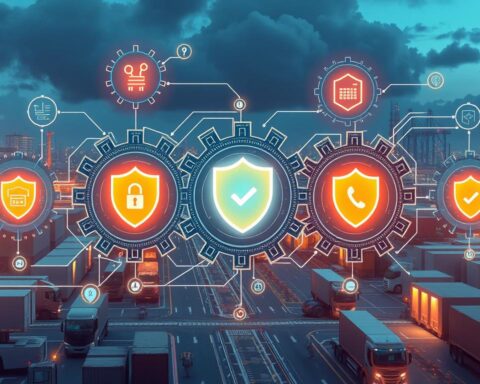In 2024, a huge 44% of companies faced a cloud data breach. Even more shocking, 14% of these happened in just the last year1. This shows how vital cyber threat intelligence is today. With threats growing fast, businesses must be proactive to protect their digital world.
The fight against cyber threats is getting tougher. Hackers use AI, like deepfakes, to trick even the best security checks, like MFA1. This shows we need new, smart ways to fight these threats.
Companies that keep a close eye on their systems can spot threats early, stopping up to 80% of attacks2. This is key because data breaches can cost a company up to $4.24 million2.
Google Threat Intelligence is changing the game. It lets companies tackle threats in minutes, not weeks3. It uses AI to sort through alerts, focusing on the real threats and cutting down on false alarms3.
Key Takeaways
- Cloud data breaches affect nearly half of organizations
- AI-driven cyber attacks are on the rise
- Continuous monitoring significantly reduces vulnerability exploitation
- The average cost of data breaches exceeds $4 million
- Advanced threat intelligence systems enable rapid response to cyber threats
- Proactive cybersecurity strategies are essential for staying ahead of attackers
Understanding the Fundamentals of Threat Intelligence
Threat intelligence is key to modern cybersecurity. As cyber threats grow, staying ahead is vital. The world of cybersecurity is changing fast, with more breaches and attacks every day4.
The Threat Intelligence Lifecycle
The threat intelligence lifecycle has six main stages:
- Direction
- Collection
- Processing
- Analysis
- Dissemination
- Feedback and Review
Each stage is important for fighting advanced threats and improving malware detection. Companies using threat intelligence can respond to threats 40% faster4.
Types of Cyber Threat Intelligence
Cyber threat intelligence includes several types:
- Strategic Intelligence
- Tactical Intelligence
- Operational Intelligence
These types help create a strong security plan. The threat intelligence market is expected to grow a lot, reaching $21.26 billion by 20264.
Role of OSINT in Intelligence Gathering
Open Source Intelligence (OSINT) is very important in threat intelligence. The internet has a lot of data, but most is hidden. About 4% is public, 90% is deep web, and 6% is dark web5.
| Data Source | Percentage of Online Data |
|---|---|
| Public Internet | 4% |
| Deep Web | 90% |
| Dark Web | 6% |
OSINT tools help find valuable threat data from these sources. But, 63% of companies say they don’t have the skills to use threat intelligence well4.
Effective threat intelligence is not just about collecting data. It’s about using that data to protect against cyber threats.
Knowing these basics helps organizations create strong threat intelligence programs. The cost of a data breach in 2021 was $4.24 million, showing the need for good threat intelligence4.
The Essential Role of Threat Intelligence Analysts
Threat intelligence analysts are key in keeping our digital world safe. They watch over organizations from cyber threats. They look into dark web forums and cybercrime shops.
Analysts help a lot with planning for cyber attacks and managing vulnerabilities. They give important info that helps teams react faster. This makes them better at finding and fixing problems early6.
Their work is vital in the huge cybersecurity field. They help fight off complex cyber attacks7. They give tips on how to defend against certain attacks and help decide what threats to tackle first7.
Working together is important in this job. Companies sharing threat info can fight threats better6. This teamwork helps everyone stay updated and improve their defenses6.
In today’s fast-changing world, using threat intelligence is a must6. Threat analysts are essential for keeping ahead of cyber threats.
Advanced Threat Detection and Analysis Techniques
Cyber threats change fast, making it key to detect and analyze them well. Using these methods can cut malware infections by up to 50%8. Let’s look at the main ways to keep modern cybersecurity strong.
Network Traffic Analysis Methods
Network traffic analysis watches and spots odd behavior in real-time. It’s key for catching threats early. Companies with threat intelligence can tackle incidents 50% quicker than others9. Cyber threat intelligence makes these methods even better, helping find and act on threats faster.
Malware Reverse Engineering Practices
Understanding and fighting malicious code is vital. Malware attacks jumped by 400% from 2019 to 20218. Experts use reverse engineering to create strong defenses against new threats.
Behavioral Analysis and Pattern Recognition
Behavioral analysis and pattern recognition spot complex attacks that traditional methods miss. These are key for testing and automating security. Companies with threat intelligence can detect and respond to threats 30% faster8.
Using these advanced methods with dark web monitoring boosts security a lot. Threat hunting can find threats in 12 hours, compared to 40 hours for old methods8. This is important because 96% of the web is dark, a hotbed for cybercrime9.
“Advanced threat detection and analysis techniques are no longer optional. They’re essential for staying ahead in the ever-evolving cybersecurity landscape.”
Security teams can greatly improve their threat detection and response by mastering these techniques. This proactive approach can cut the risk of big security breaches by 50%9. As threats keep changing, it’s vital for organizations to invest in these advanced methods to stay secure.
Cyber Threat Intelligence: Staying One Step Ahead of Attackers
In today’s digital world, cyber threat intelligence (CTI) is key to strong cybersecurity. More than 90% of companies plan to spend more on CTI by 202510. This move towards early defense is changing how we fight cyber threats.
Good threat analysis is at the heart of CTI. Teams measure their success by how well they catch threats, with 66% using this method10. By focusing on fewer security incidents, companies can lower risks and strengthen their defenses.

CTI helps a lot in planning for security incidents. Sharing intelligence gives insights that are hard to get alone11. This teamwork not only boosts response skills but also helps in making better risk plans11.
“Proactive detection and early action through threat intelligence can significantly reduce the risk of security breaches.”
To get the most from CTI, companies should:
- Focus on protecting key systems first
- Use network monitoring and scan for vulnerabilities
- Have a CTI team with data experts, security analysts, and engineers
- Join secure info-sharing groups
Though there are hurdles like privacy worries and a talent shortage, the benefits of good CTI are clear. By always analyzing threats and sharing intelligence, companies can build strong cybersecurity in a changing world.
| CTI Impact Area | Percentage | Focus |
|---|---|---|
| Investment Increase | 90% | By 2025 |
| Success Evaluation | 66% | Enhanced Detection Rates |
| Incident Reduction | 57% | Primary Goal |
Leveraging AI and Machine Learning in Threat Intelligence
AI and machine learning are changing threat intelligence. They make security better, find malware faster, and fight advanced threats. Now, companies can look at huge amounts of data quickly, making them better at finding threats12.
Predictive Analysis Capabilities
AI’s predictive analysis is a big deal in cybersecurity. It uses past attack data to find systems at high risk12. This helps cut down major security breaches by 50%13.
Automated Threat Detection Systems
AI tools watch IT systems all the time, finding threats and acting on them12. They’re great at spotting odd behavior and alerting about possible threats12. Companies with threat intelligence handle incidents 50% faster than those without13.
Real-time Response Mechanisms
AI acts fast, like isolating infected devices or blocking bad IPs, to limit cyberattack damage12. This quick action is key, as a data breach can cost about $3.86 million13. AI also helps security experts make better decisions by giving them deeper insights and helping them focus on the most important threats12.
| AI Capability | Impact on Threat Intelligence |
|---|---|
| Data Analysis | Speeds beyond human capabilities |
| Pattern Recognition | Detects unusual activity and possible threats |
| Predictive Analytics | Finds high-risk systems |
| Automated Monitoring | Keeps an eye on IT infrastructure 24/7 |
| Real-time Response | Reduces damage from cyberattacks |
Cybercrime costs are expected to hit $10.5 trillion by 2025. Using AI in cybersecurity is key for businesses to protect their digital stuff and keep customers’ trust1312. New AI tech, like federated learning and adversarial machine learning, will make AI even better at predicting cyber threats12.
Dark Web Monitoring and Intelligence Gathering
Dark web monitoring is key in today’s cybersecurity. This hidden internet part is linked to illegal activities but helps in understanding threats. Companies using dark web monitoring can turn vague threats into clear actions, improving their defense against cyber attacks14.
The role of dark web monitoring has grown a lot. From 2017 to 2020, dark web activity jumped by 300%, with data theft up 45% in 202315. These numbers show how important it is to have strong monitoring tools to fight new threats.
Advanced tools scan through lots of data to find risks and share insights on new threats. They watch for new malware and exploits, alerting companies early about data breaches and identity theft14.
Dark web monitoring does more than just find threats. It helps companies respond faster to attacks. With this, they can cut down the time to detect and handle breaches from over 200 days to under 30 days16. This quick action is key in lessening the damage from cyber attacks.
| Benefit | Impact |
|---|---|
| Attack Surface Reduction | Up to 30% |
| Threat Detection Enhancement | Up to 40% |
| Incident Response Speed Increase | 50% |
| False Positive Reduction | Approximately 25% |
Keeping an eye on the dark web is vital for strong cybersecurity. By adding dark web monitoring to their threat intelligence, businesses can learn about cyber attackers’ tactics. This helps them improve their security and stay ahead of threats.
Building Effective Threat Intelligence Networks
In today’s digital world, cybersecurity threats are changing fast. Companies must join forces to outsmart attackers. Creating strong threat intelligence networks is key for handling incidents and managing vulnerabilities.
Information Sharing Frameworks
Information sharing frameworks help companies share their knowledge and resources. This teamwork gives a clearer view of threats. In Q2 2024, companies faced 1,636 attacks per week, a 30% jump from the year before17.
Sharing threat data helps companies get ready for and tackle these threats better.
Industry Collaboration Strategies
Working together in specific sectors and sharing info across sectors is important. Almost 95% of cyberattacks aim to make money, so businesses must collaborate18. By sharing insights, companies can boost their cybersecurity and lessen vulnerabilities.
Global Intelligence Communities
International teamwork is essential in fighting cyber threats. Cybercrime could cost up to $8 trillion USD by 2023, making it a major economic force18. Global intelligence groups help countries work together, making cybersecurity stronger.
| Aspect | Impact |
|---|---|
| Information Sharing | Improved threat detection and response |
| Industry Collaboration | Enhanced vulnerability management |
| Global Cooperation | Stronger defense against international threats |
By joining these networks, companies can better handle incidents, manage vulnerabilities, and boost global cybersecurity. Threat intelligence helps make quick, informed decisions, speeding up incident response and risk management17.
Implementing Proactive Defense Strategies
In today’s digital world, companies must move from just reacting to cyber threats to actively preventing them. This shift is needed because cyber attacks are getting more complex and common. By using proactive strategies, businesses can lower the number of successful attacks and boost their security19.
Vulnerability Assessment and Management
Regular security checks, like penetration testing and vulnerability assessments, are key to strong defenses20. These steps help find weak spots before hackers can use them. By always watching systems and networks, companies can find and fix problems early, making them less vulnerable.
Incident Response Planning
Having a good plan for responding to cyber attacks is essential to limit damage. Using threat intelligence with security operations can greatly cut down the time to fix data breaches, saving a lot of money19. This helps security teams make quick, smart decisions about threats.
Security Automation Solutions
Using security automation tools is important for better threat detection and response. AI tools can spot small changes in network and user behavior, helping catch threats early20. Automated tools also help security teams by finding risks faster, saving them time19.
By using these proactive defense methods, companies can improve their cybersecurity and stay ahead of threats. Regular security checks, solid incident response plans, and advanced automation tools are the core of a strong defense20.
Conclusion
Cyber threat intelligence is key to modern cybersecurity. It helps organizations stay ahead of cyber threats in our fast-changing digital world. With the AI market growing fast, it’s becoming even more important for security21.
It’s urgent for companies to use strong cyber threat intelligence. Almost all organizations have faced APTs and phishing attacks. Ransomware attacks have also jumped by 300% in two years22. Using cyber threat intelligence can help protect against these threats and respond quickly to attacks21.
The future of cybersecurity is facing new challenges with IoT and cloud operations. These new technologies bring new risks that hackers are eager to use21. To fight these threats, companies need to invest in better security and share information. By using cyber threat intelligence, businesses can stay ahead of threats and avoid big problems2122.
FAQ
What is cyber threat intelligence?
How does threat intelligence contribute to cybersecurity strategies?
What are Advanced Persistent Threats (APTs)?
How does Open Source Intelligence (OSINT) contribute to threat intelligence?
What is the importance of dark web monitoring in cybersecurity?
How do AI and Machine Learning enhance threat intelligence?
What is the role of penetration testing in proactive defense strategies?
How can organizations effectively share threat intelligence?
What are the key components of a complete threat intelligence program?
How does behavioral analysis contribute to threat detection?
Source Links
- Cyber Threat Intelligence Review: Preparing for 2025 – https://www.infosecurity-magazine.com/news-features/cyber-threat-intelligence-review/
- Continuous Monitoring for Cyber Threats: Key Tools and Technologies to Know – https://panorays.com/blog/continuous-monitoring-for-cyber-threats/
- Google Threat Intelligence – Staying Ahead of Cyber Threats – Dito | Google Cloud & Cybersecurity Solutions – GCP, Workspace, Google Maps, Chronicle, SecOps, DevOps – https://www.ditoweb.com/2024/10/google-threat-intelligence-staying-ahead-of-cyber-threats/
- Understanding Cyber Threat Intelligence | Forefront Bits – https://forefront-systems.com/blog/understanding-cyber-threat-intelligence-1104e
- 5 Threat Intelligence Use Cases and Examples – https://www.recordedfuture.com/blog/threat-intelligence-use-cases
- Anticipating the Next Attack: The Role of Threat Intelligence in Incident Response – https://www.cyxcel.com/knowledge-hub/anticipating-the-next-attack-the-role-of-threat-intelligence-in-incident-response/
- Fusion Cyber – AI-Powered Cyber Careers – https://www.fusioncyber.co/blogs/cybersecurity/threat-intelligence-analyst-cybersecurity-role
- Cyber Threat Intelligence: Stay One Step Ahead – https://medium.com/@BillMbiya/cyber-threat-intelligence-stay-one-step-ahead-59cc05061e28
- How Threat Intelligence Analysts Stay Ahead of Cybercriminals – https://www.linkedin.com/pulse/how-threat-intelligence-analysts-stay-ahead-cybercriminals-u6ytc
- What is a Threat Intelligence Framework? – https://www.recordedfuture.com/threat-intelligence-101/tools-and-technologies/threat-intelligence-framework
- Cyber Threat Intelligence & Information Sharing | ConnectWise – https://www.connectwise.com/cybersecurity-center/glossary/threat-intelligence-sharing
- How to Leverage AI to Predict Cyber Threats to Your Business – https://agileblue.com/how-to-leverage-ai-to-predict-cyber-threats-to-businesses/
- How Threat Intelligence Analysts Stay Ahead of Cybercriminals – https://medium.com/@peris.ai/how-threat-intelligence-analysts-stay-ahead-of-cybercriminals-c6ffba93e97c
- What is Dark Web Monitoring? Definition and Tools – https://www.recordedfuture.com/blog/dark-web-monitoring
- Dark Web Monitoring Tools: 13 Best Solutions 2025 – https://www.sentinelone.com/cybersecurity-101/threat-intelligence/dark-web-monitoring-tools/
- Threat Intelligence for Security Monitoring and Incident Response – https://www.xenonstack.com/blog/threat-intelligence-for-security-monitoring-and-incident-response
- Effective Threat Intelligence Strategies for Enterprise Security | Microminder Cybersecurity | Holistic Cybersecurity Services – https://www.micromindercs.com/blog/threat-intelligence-strategies-for-enterprise-security
- Attacker Motivations Matter: Use Threat Intelligence to Stay One Step Ahead – https://resources.prodaft.com/prodaft-threat-intelligence-blog/attacker-motivations-matter-using-threat-intelligence-to-stay-one-step-ahead
- The Rise of Cyber Threat Intelligence: Leveraging Data for Proactive Defense – https://medium.com/@akitrablog/the-rise-of-cyber-threat-intelligence-leveraging-data-for-proactive-defense-693536ce2a93
- The Growing Need for Proactive Cyber Threat Intelligence in 2025 – https://www.linkedin.com/pulse/growing-need-proactive-cyber-threat-intelligence-2025-prime-calibre-ai6uc
- Cyber Threat Intelligence: Strengthening Your Organization’s Security Posture | Institute of Data – https://www.institutedata.com/us/blog/cyber-threat-intelligence-strengthening-your-organizations-security-posture/
- The Role Of Threat Intelligence In Incident Response | Cyble – https://cyble.com/knowledge-hub/the-importance-of-threat-intelligence-in-incident-response/









